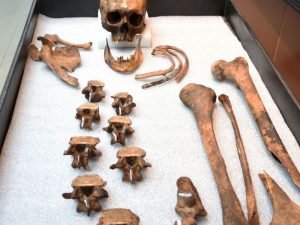In early 19th century rural New England, there was little doubt about how to deal with vampires: you dug up the corpse, took head and limbs, and rearranged them on top of the ribs in the design of a skull and crossbones. That would stop the mischevious spirit from haunting the living.
JB 55

Image: Smithsonian.com
Such was the fate that befell John Barber. And yet, as The Washington Post explains, John was no vampire. He was probably a hard-working farmer. Missing his top front teeth, he was no neck biter. He had a broken collar bone that had not healed right and an arthritic knee that may have made him limp, and he had died an awful death, probably from tuberculosis, which was so bad it had scarred his ribs.
Two hundred years later, he was destined to become the country’s only supposed “vampire” whose bones have been studied by scientists. Discovered in a plain grave with only the markings “JB 55” hammered with brass tacks on his coffin, it took modern tools to identify him. Using Y-chromosomal DNA profiling and surname prediction via genealogy data available on the Internet, the experts came up with a match for the last name: Barber.
Their work wrote the latest chapter in a project that has cast light on the eerie vampire scare in New England — Connecticut and Rhode Island especially — in the late 1700s and early 1800s, and its connection to the spread of tuberculosis, or “consumption,” as it was called.
A Terrifying Epidemic
The highly contagious disease was so wasting and terrifying that those who died of it were believed to leave their graves, infecting relatives and draining away blood and life, scholars have said.
These attacks were more mysterious and less graphic than those of the bloodsucking vampires of Gothic fiction. The terror they brought was only too real. Consumption often caused a bloody cough and left victims pale and gaunt with blood in the corners of their mouths.
As an 18th-century doctor recounted:
The emaciated figure strikes one with terror. . . The forehead covered with drops of sweat. The cheeks . . . a livid crimson. The eyes sunk. . . The breath offensive, quick and laborious.
Therapeutic Exhumation
However, it was only after death that the vampire’s true menace seemed to come, and he had to be killed again during a “therapeutic exhumation.” The suspected vampire was often a family member who had died of the disease and was thought to be infecting sons, daughters or a wife.
Family members were frequently the ones conducting the exhumation. This was being done out of fear and out of love. People were dying in their families, and they had no way of stopping it, and just maybe this was what could stop the deaths. . . . They didn’t want to do this, but they wanted to protect those that were still living.
New England had large farming families. Because they didn’t understand the transmission of the disease, you had family members who were suffering from tuberculosis sitting at the dinner table with the whole family coughing, and you had tubercular victims sleeping in one room with five or six brothers and sisters coughing. Tuberculosis was epidemic.
To Kill a Vampire
Desperate times require desperate measures. The best method of killing the suspected vampire was to check the exhumed corpse to see whether any liquid blood remained in the heart. If so, the deceased was probably a vampire, according to the belief. The heart was then removed and burned, with family members sometimes inhaling the smoke to prevent further disease.
Similar incidents have long turned up in Europe, where there are many accounts of corpses being dug up, burned, rearranged, decapitated or having stakes driven through them.
In Barber’s case, there was probably no heart to burn. So the bones of the chest were disrupted and the skull and thigh bones were placed in a ‘skull and cross-bones’ position.
John’s body remained there, undisturbed, for the next two hundred years, until modern archaeologists moved him to his new resting place: the National Museum of Health and Medicine in Silver Spring, Maryland. It can only be hoped he has finally found peace there…





What a fascinating post about the deadly maladies in 18th Century New England and their association with vampires.
I was pretty amazed to hear about it myself!
I wonder if that had anything to do with the pirate’s skull and crossbones flag, and which came first? It would be rather a coincidence if both post mortem rearrangements came about completely independent of each other.
I thought the same thing! It’s such a weird coincidence!
Fascinating history Nicholas. How did you stumble upon this? I grew up in New England and never knew about this!
I’m subscribed to the Washington Post and get all sorts of news on their newsletter 🙂